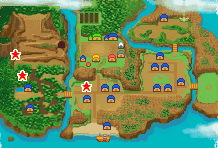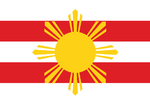Hinata
Hinata island ひなた島 | |
|---|---|
| Motto: 島から星まで (Japanese: From the island to the stars) | |
| Anthem: Sakura Sakura | |
 Hinata map | |
| Capital and largest city | Chûô |
| Official languages | Japanese |
| Demonym(s) | Hinatian |
| Government | Example |
| Lanna Harada (Independent) | |
• PM | Tarô Nakajima (NDP) |
| Legislature | Hinata National Assembly |
| Establishment | Unknow, but the latest poblation is from 2018 |
| Population | |
• (as of 2019 census) census | 21 |
| Currency | JPY |
| Time zone | +9(UTC) |
Hinata (Japanese: 日南田, ひなた [hinata]) is an island-state located in the Sea of Japan, specifically in the Tsushima Strait. Hinata was created in fall 2018 (year I in the Hinata calendar) by Japanese and Taiwanese immigrants. Power is exercised by the President (head of state) and the Secretary of State (head of government). The first is elected directly by the people, the second is the leader of the legislative majority and is elected by the Hinata National Assembly. The National Assembly is the unicameral national legislature of Hinata. It passes all laws, wrote and amends the constitution, and supervises the work of the government.
History
Before the foundation of the Hinata State
From the old stage of the island there is little information yet, however it is known that there was previous civilization on the island since some relics and archaeological remains prove it. When the current inhabitants of the island arrived, they only found a small settlement with two indigenous people in Takamachi north area, who, despite apparently not having had any relationship with beings from outside the island, understood and could communicate in a rudimentary way in Japanese. Both in Takamachi and in Chûô buildings were also found in ruins.
Beginnings and foundation
In 2018, a ferry with passengers heading towards Nagasaki was wrecked by a large storm. Five passengers of that ship, among whom was who was President of Hinata later Tarô Nakajima, survived the accident and arrived semi unconscious on the island of Hinata. The castaways saw that the island was deserted (in fact, there were indigenous people in Takamachi, but at that time it was not known). Since those people had nowhere to go, they decided to stay on that island and start a new life. From then on, new people began to arrive to inhabit the island and began to open the first shops. In the summer of the same year, Tarô Nakajima proclaimed himself Hinata's President, although shortly afterwards he called general elections due to the pressures of the small group of socialist ideology that was beginning to stand out headed by Ryūji Midoriya. Tarô Nakajima and his political formation was elected by an absolute majority after those elections and the Socialists also obtained representation in the newly founded National Assembly. From that moment a constituent process would begin that would end with a constitutional referendum.
Democratic and constitutional stage
Government
Political parties
| Party Name | Emblem | Leader(s) | Position | Seats in the National Assembly | District mayors | Government |
|---|---|---|---|---|---|---|
| Liberal Democratic Party (LDP) | Tarô Nakajima | Conservatism | 2 / 3 |
2 / 3 |
7 / 8
| |
| Hinata Socialist Party (HSP) | Ryûji Midoriya | Socialism | 1 / 3 |
1 / 3 |
0 / 8
|
Geography
Districts
The island is divided into two administrative division system:
- District: In japanese, 区 (Ku). Is the regular administrative division, governed by a district mayor elected by direct election. It has autonomy in the the sectors of culture, urbanism, agriculture, resources, economy and symbols. The Mayor can make ordinances.
- Special district: In japanese, 特別区 (Tokubetsu-ku). Administrative division administered by the Hinata government. Government appoints the special district mayor which is usually the justice minister. Special districts are those that do not have the minimum number of inhabitants to become a district.
| Flag | Arms | State | Code | Capital | Pop. | Area (km2) |
Mayor |
|---|---|---|---|---|---|---|---|
| District of Chûô |
CHO | Central Chûô | 13 | NA | Eric Nakajima LDP | ||
| District of Takamachi |
TKM | Takamachi City | 7 | NA | Chelsea Midoriya HSP | ||

|
Special district of Aoyama |
MYM | NA | 3 | NA | Ferena Nakajima LDP |
Culture

Language
The oficial language of Hinata is the Japanese. Around the 90 percent of the Hinatians know and domine this language, but about 50 percent of people can not read or write mainly because of the characters and ideograms, since they have not received basic schooling. The government of Hinata is forced in official communications, as well as for example in the electoral ballots to use few or no Chinese ideograms or Kanji, writing practically all the texts in Hiragana syllabary, since it is the most well-known writing by the population. This is a problem for cultural relations with Japan, so groups of linguistic volunteers are already developing free literacy programs for adults.
Religion
Hinata has no official religion, but exists an important community of Nichiren Shōshū Buddhists and Hinata deists (a Hinata exclusive religion). 33.33 percent of the population is atheist or agnostic.
Religion in Hinata (2019 census)
Holidays
| Name | Date | Notes |
|---|---|---|
| New Year | 1 Spring | Nonworking day |
| Hinata Goddess Festival | 8 Spring | Celebration of the birth of the Harvest Goddess |
| Spring Thanksgiving | 14 Spring | Hinata version of Valentine's Day. Working Day |
| Sheep Festival | 19 Spring | Nonworking day |
| Cooking contest | 24 Spring | Nonworking day |
| Crop Judging contest | 29 Spring | Nonworking day |
| Chicken Festival | 7 Summer | Nonworking day |
| Mining Day | 15 Summer | Nonworking day |
| Horse Festival | 23 Summer | Nonworking Day |
| Summer Fireworks | 26 Summer | |
| Crop Judging Contest | 29 Summer | Nonworking day |
| Harvest Festival | 8 Fall | Nonworking day |
| Cow Festival | 16 Fall | Nonworking day |
| Rice Festival | 24 Fall | Nonworking day |
| Crop Judging Contest | 28 Fall | Nonworking day |
| Pumpkin Festival | 30 Fall | Hinata's version of Halloween. Working day |
| Snow Festival | 4 Winter | Nonworking day |
| Dog Festival | 10 Winter | Nonworking day |
| Winter Thanksgiving | 14 Winter | Working day |
| Fishing Festival | 20 Winter | Nonworking day |
| Starry Night | 23 Winter | Working day |
| New Years Eve | 30 Winter | Nonworking day |

